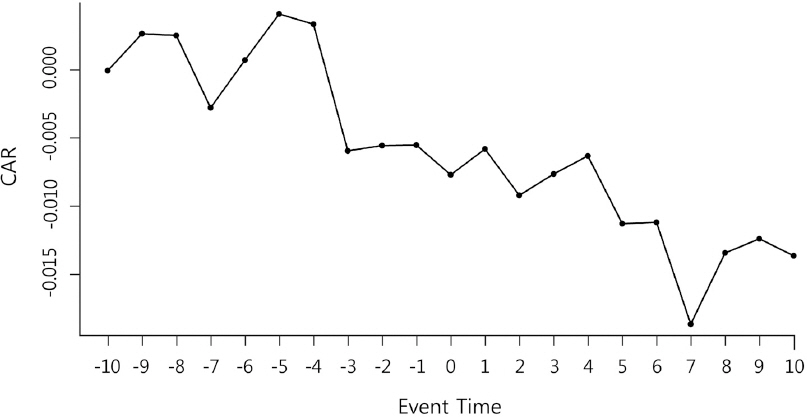Andrews, K. T, and N. Caren, 2010, Making the News: Movement Organizations, Media Attention, and the Public Agenda,
American Sociological Review, Vol. 75, pp. 841-866.

Barber, B. M, 2007, Monitoring the Monitor: Evaluating CalPERS'Activism,
The Journal of Investing, Vol. 16, pp. 66-80.

Batten, J. A, and X. V. Vo, 2015, Foreign Ownership in Emerging Stock Markets,
Journal of Multinational Financial Management, Vol. 32, pp. 15-24.

Bednar, M. K, S Boivie, and N. R Prince, 2013, Burr under the Saddle: How Media Coverage Influences Strategic Change,
Organization Science, Vol. 24, pp. 910-925.

Bushee, B. J, and G. S Miller, 2012, Investor Relations, Firm Visibility, and Investor Following,
The Accounting Review, Vol. 87, pp. 867-897.


Choi, H.H. G, W Kang, C Kim Lee, and J Park, 2016, Too Big to Jail?Company Status and Judicial Bias in an Emerging Market, Corporate Governance: An International Review, Vol. 24, pp. 85-104.
D'Aveni, R. A, and I. F. Kesner, 1993, Top Managerial Prestige, Power and Tender Offer Response:A Study of Elite Social Networks and Target Firm Cooperation during Takeovers,
Organization Science, Vol. 4, pp. 123-151.

DeAngelo, H, and L DeAngelo, 1989, Proxy Contests and the Governance of Publicly Held Corporations,
Journal of Financial Economics, Vol. 23, pp. 29-59.

DeAngelo, HL, I. F. DeAngelo, and S. C Gilson, 1994, The Collapse of First Executive Corporation Junk Bonds, Adverse Publicity, and the 'Run on the Bank'Phenomenon,
Journal of Financial Economics, Vol. 36, pp. 287-336.

Del Guercio, D, and J Hawkins, 1999, The Motivation and Impact of Pension Fund Activism,
Journal of Financial Economics, Vol. 52, pp. 293-340.

Del Guercio, D. L, and T Seery Woidtke, 2008, Do Boards Pay Attention when Institutional Investor Activists ŌĆ£just vote noŌĆØ?,
Journal of Financial Economics, Vol. 90, pp. 84-103.

Dodd, P, and J. B Warner, 1983, On Corporate Governance: A Study of Proxy Contests,
Journal of Financial Economics, Vol. 11, pp. 401-438.

Dyck, A, and L Zingales, 2002, The Corporate Governance Role of the Media, in World Bank ed.: The Right to Tell: The Role of Mass Media in Economic Development, World Bank Publications, Washington, DC:
English, P. C II, T. I Smythe, and C. R McNeil, 2004, The ŌĆ£CalPERS EffectŌĆØ Revisited,
Journal of Corporate Finance, Vol. 10, pp. 157-174.

Ertimur, Y.F, Ferri, and V Muslu, 2010, Shareholder Activism and CEO Pay,
The Review of Financial Studies, Vol. 24, pp. 535-592.


Fama, E. F, and M. C. Jensen, 1983, Separation of Ownership and Control,
The Journal of Law and Economics, Vol. 26, pp. 301-325.

Ferri, F, 2013, 'Low-cost'Shareholder Activism:A Review of the Evidence, C. A. Hill, B. H. McDonnell(Eds.), Research Handbook of the Economics of Corporate Law, Edward Elgar Publishing, Cheltenham, Glos:

Fich, E. M, and A. Shivdasani, 2007, Financial Fraud, Director Reputation, and Shareholder Wealth,
Journal of Financial Economics, Vol. 86, pp. 306-336.

Gillan, S. L, and L. T. Starks, 2000, Corporate Governance Proposals and Shareholder Activism: The Role of Institutional Investors,
Journal of Financial Economics, Vol. 57, pp. 275-305.

Gillan, S. L, and L. T. Starks, 2007, The Evolution of Shareholder Activism in the United States,
Journal of Applied Corporate Finance, Vol. 19, pp. 55-73.

Grundfest, J. A, 1992, Just Vote No: A Minimalist Strategy for Dealing with Barbarians Inside the Gates Stan,
Rev L, Vol. 45 (4), pp. 857-937.

Ikenberry, D, and J Lakonishok, 1993, Corporate Governance Through the Proxy Contest:Evidence and Implications,
Journal of Business, Vol. 66 (3), pp. 405-435.

Joh, S. W, 2003, Corporate Governance and Firm Profitability: Evidence from Korea before the Economic Crisis,
Journal of Financial Economics, Vol. 68, pp. 287-322.

Karpoff, J. M, P. H Malatesta, and R. A Walkling, 1996, Corporate Governance and Shareholder Initiatives:Empirical Evidence,
Journal of Financial Economics, Vol. 42, pp. 365-395.

Kim, H. N, and K. H Yon, 2014, The Management Monitoring Effect of Institutional Investors'No Vote, Korean Journal of Financial Studies, Vol. 43, pp. 1-22.
Kim, S.H, S Byun, and E. J Lee, 2014, Does ŌĆ£Vote NoŌĆØ Change Corporate Governance and Firm Value?Evidence from the Shareholder Activism of the Korean National Pension Service,
Emerging Markets Finance and Trade, Vol. 50, pp. 42-59.

Kim, W.W, Kim, and K.-S Kwon, 2009, Value of Outside Blockholder Activism:Evidence from the Switchers,
Journal of Corporate Finance, Vol. 15, pp. 505-522.

Lee, Y. K, H Yon, and H Kim, 2017, The Effectiveness of 'No'Voting Right of Institutional Investors based on Improvement of Independence of the Board of Directors,
Korean Journal of Financial Studies, Vol. 46, pp. 61-96.

McCombs, M. E, and D. L Shaw, 1972, The Agenda-Setting Function of Mass Media,
Public Opinion Quarterly, Vol. 36, pp. 176-187.


Mills, C. W, 2000, The Power Elite, Oxford University Press, Oxford, England:
Mulherin, J. H, and A. B Poulsen, 1998, Proxy Contests and Corporate Change:Implications for Shareholder Wealth,
Journal of Financial Economics, Vol. 47, pp. 279-313.

Nelson, J. M, 2006, The ŌĆ£CalPERS EffectŌĆØ Revisited Again,
Journal of Corporate Finance, Vol. 12, pp. 187-213.

Smith, M. P, 1996, Shareholder Activism by Institutional Investors:Evidence from CalPERS,
The Journal of Finance, Vol. 51, pp. 227-252.

Sohn, S, and C Bae, 2018, The Effect of 'No'Voting Right of Institutional Investors on the Credit Rating,
Korean Management Review, Vol. 47, pp. 1515-1540.

Spence, M, 2002, Signaling in Retrospect and the Informational Structure of Markets,
American Economic Review, Vol. 92, pp. 434 pp. 459.

Thomas, R. S, and Cotter J. F., 2007, Shareholder Proposals in the New Millennium:Shareholder Support, Board Response, and Market Reaction,
Journal of Corporate Finance, Vol. 13, pp. 368-391.

Wahal, S, 1996, Pension Fund Activism and Firm Performance,
Journal of Financial and Quantitative Analysis, Vol. 31, pp. 1-23.










